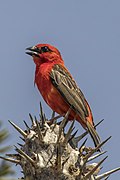Superregnum: Eukaryota
Regnum: Animalia
Subregnum: Eumetazoa
Cladus: Bilateria
Cladus: Nephrozoa
Superphylum: Deuterostomia
Phylum: Chordata
Cladus: Craniata
Subphylum: Vertebrata
Infraphylum: Gnathostomata
Superclassis: Tetrapoda
Cladus: Reptiliomorpha
Cladus: Amniota
Classis: Reptilia
Cladus: Eureptilia
Cladus: Romeriida
Subclassis: Diapsida
Cladus: Sauria
Infraclassis: Archosauromorpha
Cladus: Crurotarsi
Divisio: Archosauria
Subsectio: Ornithodira
Subtaxon: Dinosauromorpha
Cladus: Dinosauria
Ordo: Saurischia
Cladus: Theropoda
Cladus: Neotheropoda
Infraclassis: Aves
Ordo: Passeriformes
Subordo: Passeri
Infraordo: Passerida
Superfamilia: Passeroidea
Familia: Ploceidae
Genus: Foudia
Species: F. aldabrana - F. eminentissima - F. flavicans - F. madagascariensis - F. omissa - F. rubra - F. sechellarum
Name
Foudia Reichenbach, 1850
References
Av. Syst. Nat. pl.LXXIX
IOC version 9.2
Fodies are small passerine birds belonging to the genus Foudia in the weaver family Ploceidae.
Description
The birds are 12 to 15 centimetres (4.7 to 5.9 in) long and have short, conical bills. Males in breeding plumage are usually colourful with bright red or yellow on the head and sometimes elsewhere. Non-breeding males and females are dull, sparrow-like birds with mostly grey-brown plumage.
Fodies are typically found in forest, woodland or scrubland but some also occur in man-made habitats, especially the red fody. Some species feed mainly on seeds while others are largely insectivorous. Fodies build a dome-shaped nest of grass and other plant material. It has a side-opening and it is suspended from a branch or palm leaf.
The genus was introduced by the German naturalist Ludwig Reichenbach in 1850.[1] The type species was subsequently designated as the red fody.[2] Foudi or Fodi is the Malagasy name for the red fody.[3]
Species list
The genus contains eight species:[4]
| Image | Common name | Scientific name | Distribution |
|---|---|---|---|
 |
Red fody or Madagascar fody | Foudia madagascariensis | Madagascar |
| Comoros fody or red-headed fody | Foudia eminentissima | Comoros, Mayotte and Seychelles | |
| Aldabra fody | Foudia aldabrana | Aldabra Island | |
 |
Forest fody | Foudia omissa | Madagascar. |
 |
Mauritius fody | Foudia rubra | Mauritius |
| Seychelles fody | Foudia sechellarum | Seychelles islands of Cousin Island, Cousine Island, Frégate Island | |
| Rodrigues fody | Foudia flavicans | Mauritius | |
| Réunion fody | Foudia delloni | Réunion. |
Distribution
They are native to the islands of the western Indian Ocean where they occur on Madagascar, the Seychelles, the Comoro Islands and the Mascarene Islands. The red fody has also been introduced to the Chagos Archipelago, Bahrain and Saint Helena. While the red fody is one of the most common birds of the region, several of the other fodies are considered to be threatened, particularly the Mauritius fody which is classed as endangered.
References
Reichenbach, Ludwig (1850). Avium Systema Naturale. Das natürliche System der Vögel. Dresden: Expedition der Vollständigsten Naturgeschichte. Plate 79.
Mayr, Ernst; Greenway, James C. Jr, eds. (1962). Check-list of birds of the world. Volume 15. Cambridge, Massachusetts: Museum of Comparative Zoology. p. 62.
Jobling, J.A. (2018). del Hoyo, J.; Elliott, A.; Sargatal, J.; Christie, D.A.; de Juana, E. (eds.). "Key to Scientific Names in Ornithology". Handbook of the Birds of the World Alive. Lynx Edicions. Retrieved 6 May 2018.
Gill, Frank; Donsker, David, eds. (2018). "Old World sparrows, snowfinches, weavers". World Bird List Version 8.1. International Ornithologists' Union. Retrieved 5 May 2018.
Sources
Wikispecies has information related to Foudia.
Sinclair, Ian & Langrand, Olivier (1998) Birds of the Indian Ocean Islands, Struik, Cape Town.
Skerrett, Adrian; Bullock, Ian & Disley, Tony (2001) Birds of Seychelles, Christopher Helm, London.
Retrieved from "http://en.wikipedia.org/"
All text is available under the terms of the GNU Free Documentation License

